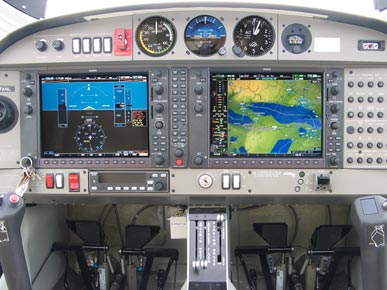| Flying |
Diamond in the Rough
By John
“Wingnut” Hazlett
 One
of the best things about being a renter of airplanes, is that you get
the opportunity to fly some planes that you’d never be able to afford
if you had to buy them. In my case, this means “any plane”,
but that’s another story. One
of the best things about being a renter of airplanes, is that you get
the opportunity to fly some planes that you’d never be able to afford
if you had to buy them. In my case, this means “any plane”,
but that’s another story.
The other day, I got a note
from a local FBO that they now have a Diamond DA-40 with constant speed
prop and a Garmon G1000 panel. I’d known for a while that they were
planning on getting one, but back when I first heard about it they were
saying that I’d have to have many more hours of flight time than
I do to rent it. This didn’t set very well with me, so I went to
another FBO and began building my “glass panel time” in a
brand new Cessna 172SP with the G1000 and A/C! By the time I heard that
they actually HAD the DA40, I had built up about 13-14 hours of G1000
time and a couple of those hours were actually night flights, as well.
At this time, I had about 150 hours total time in my log book.
 Well,
I guess the FBO with the DA40 decided that they’d never get enough
business for it if they limited their renters to those with 250 hours
or more, so they’d changed their tune to 125 hours, + a checkout
with the G1000 panel. This is usually good for another 5-10 hours with
an instructor. Well,
I guess the FBO with the DA40 decided that they’d never get enough
business for it if they limited their renters to those with 250 hours
or more, so they’d changed their tune to 125 hours, + a checkout
with the G1000 panel. This is usually good for another 5-10 hours with
an instructor.
Since I already had the G1000
endorsement, and the additional 13 hours of actual flight time with it,
all I’d need to do is get checked out in the DA40 itself. Nice.
The DA40 has sticks instead of yokes, so I was very excited when I made
my first reservation. So much so that I had a hard time sleeping the night
before.
When I got down to the FBO
on Saturday morning, I met my instructor and went out for a preflight
and to review the plane’s specific idiosyncrasies. The instructor
had worked at the other FBO (the one with the G1000/172) and knew that
I had covered those requirements, so there was no usual song and dance
about getting up to speed with the panel before flying. Instead, we covered
ground handling – the DA40 has a free-castoring nose wheel and very
wide wingspan, so it would be a little different than a 172/182, and there
were a few other differences that needed to be covered, like flaps and
power settings, etc. We covered all of this during the preflight, and
were ready to taxi out and go for a ride.
 I
was still excited. I
was still excited.
While we were pulling down
the bubble canopy, people were taking our picture in the plane, etc. It
felt pretty cool. But when we got to the holding point down at the end
of runway 28, the warning buzzer went off and the circuit breaker for
the alternator popped out. We pushed it back in and it stayed there for
no more than 30 seconds, then popped right back out again. We tried turning
off the strobes, etc., but still no luck. After a few minutes, I suggested
that we go ahead and take off and stay in the pattern in case we still
had troubles. He was OK with this approach.
We lined up on the runway and
advanced the throttle to full, with full prop and one flap notch. The
flaps are not marked in degrees, and there are only two settings. You
use the first when taking off, then again when abeam the numbers on downwind,
then you put in the last notch on final approach to land. This plane has
a long, skinny wing with a winglet at the end, and is very slippery by
design. The instructor was very clear about needing the first setting
of flaps, and I believed him.
As we hit the 56Kt mark, I
eased the stick back slightly and brought the nose wheel up. By 66kts,
we were heading skyward at an impressive climb rate. The controls were
extremely light and responsive. It flew very nicely. The controls are
located a little differently than what I’m used to, but not so much
as to feel strange, and I quickly got a feel for the plane. At 400’,
I took out the flaps and reduced power to 25/25. We were keeping a speed
of about 112 kts as we turned crosswind. There was a 172 and a 152 in
the pattern, so I went very wide.
I came around for downwind and heard another 172 calling downwind, and
could see him on my panel (traffic), so we let him cut inside for base
and final. He made a comment about me needing to file for cross-country
if I was going to make the pattern that wide, but as I turned final and
dropped my second setting of flaps, I was close enough to him to make
him hurry.
 I
made my first touch-n-go very smoothly. I love the way a low wing plane
gets down into ground effect and lands so cushy like that. Even with the
laminar flow wing, this thing is sweet down on the deck! We touched down
cleanly on the mains at about 67kts with no bounce, and barely a chirp.
I gunned it up and off we went again. This time, there were no other planes
in the pattern, so I kept it tighter than last time. I was also concerned
because the fuse was out again and we were losing electrical power. I
wanted to be sure to be able to get down quickly if things started to
fail. I
made my first touch-n-go very smoothly. I love the way a low wing plane
gets down into ground effect and lands so cushy like that. Even with the
laminar flow wing, this thing is sweet down on the deck! We touched down
cleanly on the mains at about 67kts with no bounce, and barely a chirp.
I gunned it up and off we went again. This time, there were no other planes
in the pattern, so I kept it tighter than last time. I was also concerned
because the fuse was out again and we were losing electrical power. I
wanted to be sure to be able to get down quickly if things started to
fail.
I did three touch-n-goes, and
then departed the pattern for a few minutes so that I could get a feel
for speed management when re-entering the pattern. It turns out that you
need to get the manifold pressure down to about 16psi with full prop to
slow down to 90kts, which is where the first flap setting comes in.
By now, we’d lost too
much charge to continue, and the electric trim had just failed. There’s
a very nicely placed manual trim wheel right between the front seats,
and all you have to do is rock your forearm back and forth to adjust it
while keeping your hand on the throttle/mixture/prop controls. The trim
in the DA40 is about ten times more sensitive than in the Cessna, too.
It’s like Brill-Crème – a little dab’ll do ya!
Well, because the alternator
was crapped out, I didn’t get to do any stalls or basic maneuvers
other than basic pattern work, but from what I did get to do, I could
tell I liked this plane. I love the sticks, which are very short and are
controlled more by thinking what you want to do than by actually horsing
them around. I loved the visibility, which is outstanding, except for
when facing the sun. I still like the high-wings when it comes to that.
It felt cool to be able to look behind me while in flight, but a little
unnerving to not be able to see the rudder at all before take-off.
 When
we got back in the FBO, the old-timers were not as impressed as I was.
They’d heard all the other problems the plane has had since they
got it, and have decided it’s a lemon. I’m reserving judgment
myself, because I haven’t had a chance to try anything else for
myself yet. I’m still hoping that they get the problem fixed during
the week and I’ll get a chance to go back up and finish my mission. When
we got back in the FBO, the old-timers were not as impressed as I was.
They’d heard all the other problems the plane has had since they
got it, and have decided it’s a lemon. I’m reserving judgment
myself, because I haven’t had a chance to try anything else for
myself yet. I’m still hoping that they get the problem fixed during
the week and I’ll get a chance to go back up and finish my mission.
I’m really hoping
this works out, because it’ll give me another option for renting
within my local area, and that’s always good. I’ll keep you
posted. Meanwhile, I bet the other local FBO decides to maintain it’s
own fleet a little better since they’ll be getting some competition
from the DA40. That’s a very good thing from a renter’s prospective.
Fair
winds and blue skies,
|
|

